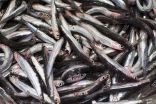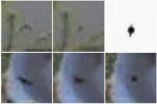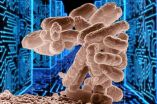(Press-News.org) Nanoparticles will soon be used as tiny shuttles to deliver genes to cells and drugs to tumors in a more targeted way than was possible in the past.
But as the scientists prepare to use the nanoparticles in medicine, concerns have arisen about their potential toxicity.
Studies of both the applications of nanoparticles and their toxicity rely on the ability of scientists to quantify the interaction between the nanoparticles and cells, particularly the uptake (ingestion) of nanoparticles by cells.
In the standard laboratory tests of the biological activity of nanoparticles, cells are plated on the bottom of a dish and culture medium containing nanoparticles is poured on top of them.
It seems straightforward enough. But recently Washington University in St. Louis scientist Younan Xia started to worry about the in vitro experiments his lab was doing with gold nanoparticles.
What if the cells were upside down, he wondered? Would that make a difference? Would it change their uptake rate?
"People assumed that if they prepared a suspension, the suspension was going to have the same concentration everywhere, including at the surface of the cells," says Xia, PhD, the James M. McKelvey Professor in the Department of Biomedical Engineering.
A battery of experiments in Xia's lab with both the standard and upside-down setups showed that nanoparticles above certain sizes and weights will settle out. So concentrations of the nanoparticles near the cell surfaces are different from those in the bulk solution and cellular uptake rates are higher.
As the scientists conclude in the Nature Nanotechnology article describing the experiments, "Studies on the cellular uptake of nanoparticles that have been conducted with cells in the upright configuration may have given rise to erroneous and misleading data."
Topsies and Turveys
Scientists have felt they could safely assume that the concentration of nanoparticles in the fluid next to the cells, which drives cellular uptake, was the same as the initial concentration of nanoparticles in the medium because the particles are small enough to be easily lofted by Brownian motion, the random motion of the molecules in the liquid.
Gravity, by this accounting, did not override this force for diffusion and the nanoparticles stayed in solution instead of settling out.
"We started to wonder, however, because our nanoparticles are made of gold," Xia says. "Gold is nontoxic but it is also very heavy, so it was conceivable relatively large nanoparticles might settle."
Since it is impossible to measure the exact concentration of gold nanoparticles at the surface of a cell, Xia and coworkers designed a simple experiment to test whether settling changed the concentration there and the cellular uptake.
Xia's lab tested gold nanospheres of three sizes, nanocages of two edge lengths, and nanorods, some with surface coatings that picked up serum proteins in solution and others coated with a chemical that acts as an antifouling agent.
After the cells were incubated in the nanoparticle-bearing medium, the concentration of the nanoparticles in the medium was measured spectroscopically and the number of particles each cell had taken up was calculated from the difference in the concentrations.
In the literature, Xia says, there are reports that the cellular uptake of nanoparticles depends on the nanoparticles' size, shape and surface coating.
His lab's experiments showed that these characteristics are secondary, relevant only insofar as they affect the sedimentation and diffusion velocities of the nanoparticles.
For small, light particles, there was no disparity between the cells in the upright and the upside-down configurations. In the case of larger, heavier particles, however, sedimentation dominated, and the upright cells took in more nanoparticles than the upside-down cells.
"All earlier work may need to be re-evaluated to account for the effects of sedimentation on nanoparticle dosimetry," the authors conclude.
"It's no different from medicines that have to be shaken to suspend a powder in a water. If you don't shake the bottle," Xia says, "you end up under- or overdosing yourself."
INFORMATION:
Inverting a standard experiment sometimes produces different results
An overlooked detail of experimental design may invalidate some prior experiments with nanoparticles
2011-04-29
ELSE PRESS RELEASES FROM THIS DATE:
Fish livers contain beneficial fatty acids
2011-04-29
The fishing industry usually discards fish livers, but a team of researchers from the University of Almeria (Spain) has confirmed that they are a good source of polyunsaturated fatty acids, which are beneficial to health. Anchovies are one of the fish whose livers contain the highest levels of these substances.
Fish livers have hardly been used to date, with exceptions such as cod livers, which are used to produce the well-known medicinal oil. In general, fishermen tend to throw fish entrails away into the sea, and if they make it to processing plants they are one of ...
Dr. Michael Collins publishes paper on ivory-billed woodpecker
2011-04-29
Dr. Michael Collins, Naval Research Laboratory scientist and bird watcher, has published an article titled "Putative audio recordings of the Ivory-billed Woodpecker (Campephilus principalis)" which appears in the March issue of the Journal of the Acoustical Society of America. The audio recordings were captured in two videos of birds with characteristics consistent with the Ivory-billed Woodpecker. This footage was obtained near the Pearl River in Louisiana, where there is a history of unconfirmed reports of this species. During five years of fieldwork, Collins had ten ...
New insight into chromosome segregation: Centromere-independent kinetochore assembly
2011-04-29
One of the most critical tasks that a dividing cell must accomplish is the successful delivery of a complete set of genetic information to each new daughter cell. Now, a study published by Cell Press in the April 29th issue of the journal Cell, provides fascinating new insight into the complex of proteins that orchestrates the proper segregation of human chromosomes during cell division.
During the process of mitosis, DNA and its associated packing proteins are arranged into structures called chromosomes that are duplicated and then segregated. Duplicated chromosomes ...
Nanotechnologists must take lessons from nature
2011-04-29
It's common knowledge that the perfect is the enemy of the good, but in the nanoscale world, perfection can act as the enemy of the best.
In the workaday world, engineers and scientists go to great lengths to make the devices we use as perfect as possible. When we flip on a light switch or turn the key on the car, we expect the lights to come on and the engine to start every time, with only rare exceptions. They have done so by using a top-down design process combined with the application of large amounts of energy to increase reliability by suppressing natural variability.
However, ...
Era of canopy crane ending; certain research and education activities remain
2011-04-29
The 25-story construction crane used since 1995 to investigate such things as how Pacific Northwest forests absorb carbon dioxide, obtain sufficient water and resist attacks by pests and diseases is being pruned back to just the tower.
The Wind River Canopy Crane, located in a 500-year-old forest near Stevenson in southwest Washington, has been operated cooperatively by the University of Washington, the Forest Service's Pacific Northwest Research Station and the Gifford Pinchot National Forest. The partners say the jib – the arm of the crane – is being removed because ...
Pediatric flu vaccination: Understanding low acceptance rates could help increase coverage
2011-04-29
A study of H1N1 and seasonal influenza vaccination in a sample of black and Hispanic children in Atlanta found a low rate of vaccine acceptance among parents and caregivers. Only 36 percent of parents and caregivers indicated they would immunize children against H1N1, and 22 percent indicated their children received the seasonal influenza vaccine in the previous three months. The majority of children in the sample (71 percent) were from households with less than $40,000 in annual income.
Researchers say this low level of vaccine coverage and acceptance highlights the ...
As the worm turns, its secrets are revealed
2011-04-29
An international team of scientists, led by researchers at the University of California, San Diego School of Medicine, have developed a new method for discerning the functions of previously uncharacterized genes and placing them in interactive, functional networks that reveal how gene products interact to bring about cellular events.
The research is published in the April 29 issue of the journal Cell. It was led by principal investigators Karen Oegema, PhD, professor of cellular and molecular medicine and head of the Laboratory of Mitotic Mechanisms in the Ludwig Institute ...
From the beginning, the brain knows the difference between night and day
2011-04-29
The brain is apparently programmed from birth to develop the ability to determine sunrise and sunset, new research on circadian rhythms at the University of Chicago shows.
The research sheds new light on brain plasticity and may explain some basic human behaviors, according to Brian Prendergast, associate professor in psychology at the University of Chicago and co-author of a paper published April 27 in the journal PLoS One. The lead author is August Kampf-Lassin, an advanced graduate student at the University.
"This finding may show us why infants of many species eventually ...
Get The Labels You Adore For Prices You Love at TK Maxx Crewe
2011-04-29
The long-awaited TK Maxx store is nearly ready to open its doors at the Grand Junction Retail Park, Crewe. This new store is set to open on Thursday 28 April at 9am and will feature nearly 20,000 sq ft of famous label fashion, shoes and accessories for men and women plus homewares, kids and toys - all at up to 60% off the RRP.
The first lucky 500 customers through the doors at 9am will be treated to a GBP10 gift card to spend in the new store.
The TK Maxx concept is simple. TK Maxx buyers shop the world all year round working direct with designers and negotiating ...
Study: Cotton swabs prove problematic for ear health
2011-04-29
DETROIT – A study by Henry Ford Hospital shows a direct association between cotton swab use and ruptured eardrum.
The study also shows that in most cases the rupture heals on its own and surgery is only necessary for the most severe cases.
"In the past, many otolaryngologists have wondered if surgery is really necessary to treat a ruptured eardrum. The results of this study show that 97 percent of cases healed on their own within two months, proving that most cases do not require surgery," says Ilaaf Darrat, M.D., an otolaryngologist at Henry Ford Hospital and co-author ...
LAST 30 PRESS RELEASES:
Making lighter work of calculating fluid and heat flow
Normalizing blood sugar can halve heart attack risk
Lowering blood sugar cuts heart attack risk in people with prediabetes
Study links genetic variants to risk of blinding eye disease in premature infants
Non-opioid ‘pain sponge’ therapy halts cartilage degeneration and relieves chronic pain
AI can pick up cultural values by mimicking how kids learn
China’s ecological redlines offer fast track to 30 x 30 global conservation goal
Invisible indoor threats: emerging household contaminants and their growing risks to human health
Adding antibody treatment to chemo boosts outcomes for children with rare cancer
Germline pathogenic variants among women without a history of breast cancer
Tanning beds triple melanoma risk, potentially causing broad DNA damage
Unique bond identified as key to viral infection speed
Indoor tanning makes youthful skin much older on a genetic level
Mouse model sheds new light on the causes and potential solutions to human GI problems linked to muscular dystrophy
The Journal of Nuclear Medicine ahead-of-print tip sheet: December 12, 2025
Smarter tools for peering into the microscopic world
Applications open for funding to conduct research in the Kinsey Institute archives
Global measure underestimates the severity of food insecurity
Child survivors of critical illness are missing out on timely follow up care
Risk-based vs annual breast cancer screening / the WISDOM randomized clinical trial
University of Toronto launches Electric Vehicle Innovation Ontario to accelerate advanced EV technologies and build Canada’s innovation advantage
Early relapse predicts poor outcomes in aggressive blood cancer
American College of Lifestyle Medicine applauds two CMS models aligned with lifestyle medicine practice and reimbursement
Clinical trial finds cannabis use not a barrier to quitting nicotine vaping
Supplemental nutrition assistance program policies and food insecurity
Switching immune cells to “night mode” could limit damage after a heart attack, study suggests
URI-based Global RIghts Project report spotlights continued troubling trends in worldwide inhumane treatment
Neutrophils are less aggressive at night, explaining why nighttime heart attacks cause less damage than daytime events
Menopausal hormone therapy may not pose breast cancer risk for women with BRCA mutations
Mobile health tool may improve quality of life for adolescent and young adult breast cancer survivors
[Press-News.org] Inverting a standard experiment sometimes produces different resultsAn overlooked detail of experimental design may invalidate some prior experiments with nanoparticles





